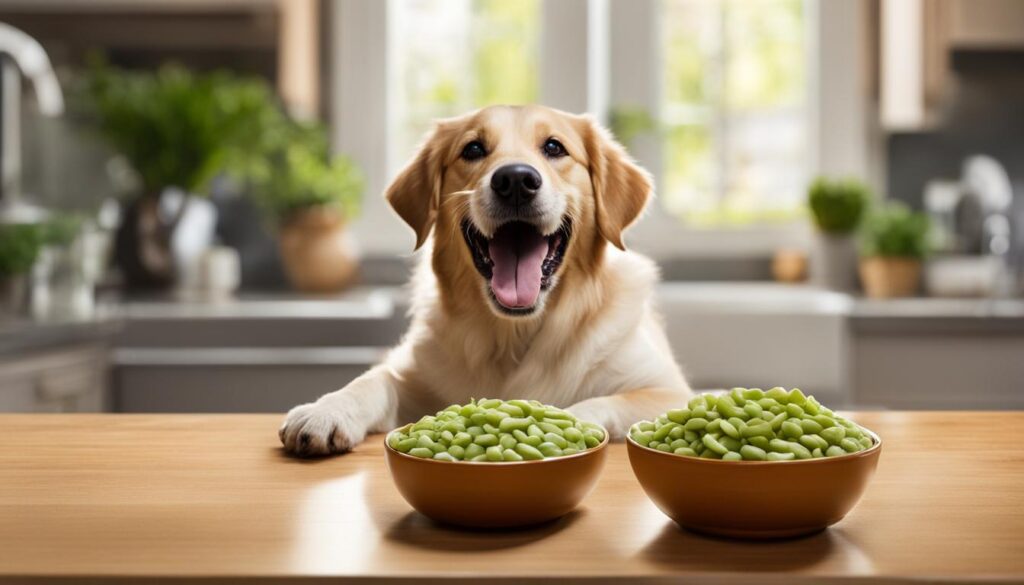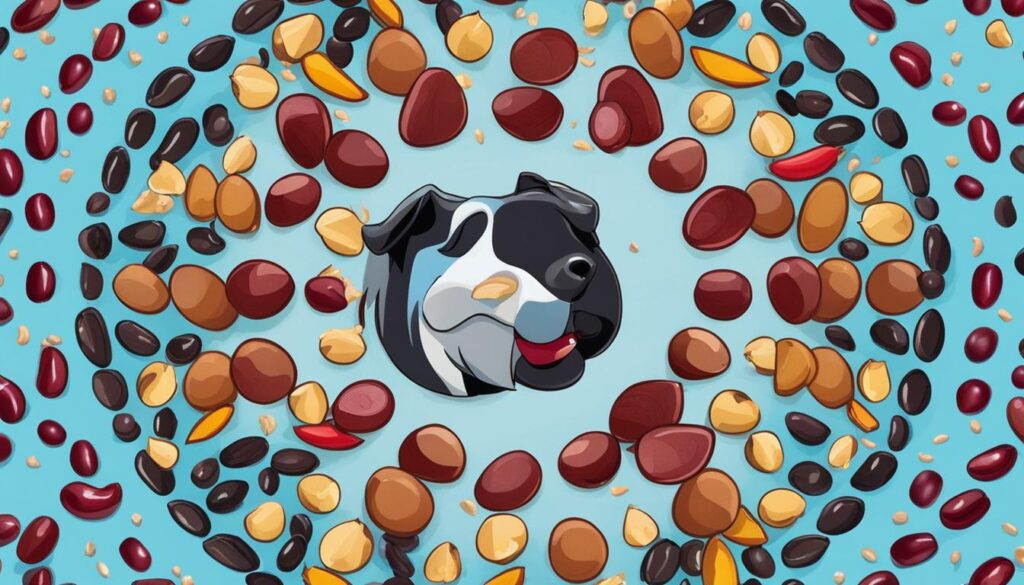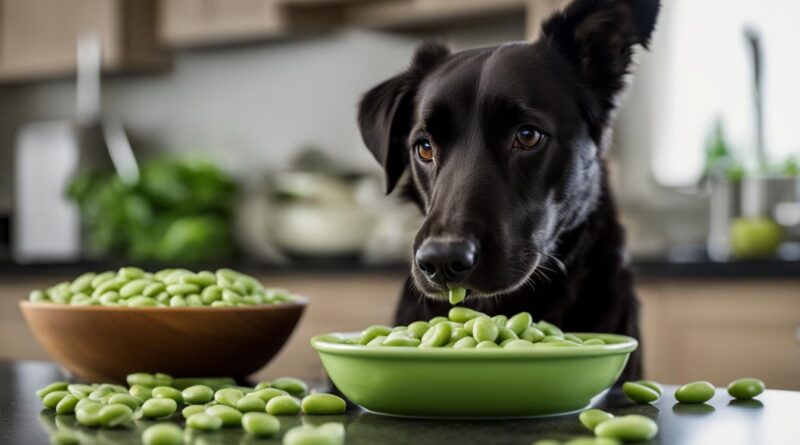Can Dogs Have Lima Beans: Are Lima Beans Safe for Dogs to Eat?
Welcome to our article on whether or not dogs can have lima beans. Lima beans are a type of legume that is often included in human diets for their nutritional benefits. But can dogs safely eat them too? Let’s find out!
Dogs are omnivores, which means they can eat a variety of plant-based foods in addition to meat. While some legumes can be harmful to dogs, there are dog-friendly legumes that can be a safe and healthy addition to their diet. Lima beans are one such option.
When considering the safety of beans for dogs, it’s essential to look at their nutritional composition. Lima beans are low in calories and cholesterol while being high in fiber, carbohydrates, protein, and essential vitamins. These nutrients can contribute to a balanced diet for dogs.
However, it’s important to introduce new foods gradually and monitor your dog for any allergies or digestive issues. While lima beans are generally safe for dogs, individual reactions can vary. It’s always a good idea to consult with your veterinarian before making any major dietary changes for your furry friend.
Key Takeaways:
- Lima beans can be safely included in a dog’s diet.
- They are low in calories and cholesterol while being high in fiber, carbs, protein, and essential vitamins.
- Introduce new foods gradually and monitor for any adverse reactions.
- Consult with a veterinarian before making significant dietary changes for your dog.
- Lima beans are just one type of bean that can be beneficial for dogs, along with black beans, kidney beans, pinto beans, green beans, edamame, and black-eyed peas.
The Benefits of Lima Beans for Dogs
Lima beans offer several benefits for dogs. They are high in protein, providing a valuable source of nutrition that can supplement their animal protein intake. Protein is essential for muscle development and repair, supporting your dog’s overall health and vitality.
Additionally, lima beans are rich in dietary fiber. Fiber is important for maintaining a healthy digestive system and promoting regular bowel movements. It aids in preventing constipation and keeps your dog’s gastrointestinal tract functioning optimally.
Moreover, lima beans contain a wide range of vitamins and minerals that contribute to your dog’s well-being. These include magnesium, potassium, iron, manganese, vitamin C, and folate. These nutrients support various bodily functions, such as heart health, bone strength, and immune system function.
Here is a breakdown of the key nutrients found in lima beans:
| Nutrient | Benefits |
|---|---|
| Protein | Aids in muscle development and repair |
| Dietary Fiber | Supports healthy digestion and regular bowel movements |
| Magnesium | Essential for nerve function and muscle health |
| Potassium | Helps regulate blood pressure and maintain proper hydration |
| Iron | Assists in the production of healthy red blood cells |
| Manganese | Contributes to bone health and metabolism |
| Vitamin C | Supports the immune system and collagen production |
| Folate | Plays a crucial role in cell division and growth |
Feeding your dog lima beans in moderation can provide these valuable nutrients and promote their overall well-being. However, it is important to introduce new foods gradually and monitor your dog for any allergic reactions or digestive issues.

Remember to consult with your veterinarian before making any significant changes to your dog’s diet. They can provide individualized advice and ensure the safe and appropriate incorporation of lima beans into your dog’s meal plan.
How to Safely Feed Lima Beans to Dogs
When it comes to incorporating lima beans into your dog’s diet, proper preparation and portioning are key to ensuring their safety and nutritional benefits. Follow these guidelines to safely feed lima beans to your furry friend:
- Cook the lima beans: Raw lima beans can be toxic to dogs, so it is essential to cook them thoroughly before serving. This will make them safe and easier for your dog to digest.
- Avoid seasonings and additives: Keep the lima beans plain and free from any seasonings or additives. Dogs have sensitive stomachs, and certain spices or ingredients may cause dietary and digestive issues.
- Avoid canned lima beans: Canned lima beans usually contain high levels of sodium, which can be harmful to dogs. Opt for fresh or dried lima beans instead, as they offer a healthier and safer choice.
- Start with small portions: Introduce lima beans gradually into your dog’s diet to allow their digestive system to adjust. Start with small portions and observe any adverse reactions such as gastrointestinal upset or allergies.
Remember, every dog is unique, so it’s essential to consult with your veterinarian before making any significant changes to their diet. They can provide specific guidance tailored to your dog’s individual needs and ensure the safe inclusion of lima beans. Now that you know how to safely prepare and feed lima beans to your dog, let’s dive deeper into other dog-friendly beans in the next section.

| Preparation Steps | Portion Size |
|---|---|
| Cook the lima beans thoroughly | Start with small portions and monitor for adverse reactions |
| Avoid adding seasonings or additives | Consult with a veterinarian for specific portion recommendations |
| Avoid canned lima beans | Gradually increase portion size if well-tolerated |
Other Beans That Dogs Can Eat
In addition to lima beans, there are several other beans that can be safely consumed by dogs. These include:
- Green beans
- Black beans
- Kidney beans
- Pinto beans
- Garbanzo beans (chickpeas)
- Black-eyed peas
Each type of bean offers its own nutritional benefits and can be a healthy addition to a dog’s diet when prepared and fed safely.

These dog-friendly beans are packed with essential nutrients that can contribute to your furry friend’s overall health and wellness. Whether you choose to serve them steamed, boiled, or pureed, these beans provide a great source of protein, fiber, vitamins, and minerals.
“Beans are not only delicious but also a great way to incorporate variety into your dog’s diet. Just like with lima beans, it’s important to introduce other beans gradually into your dog’s meals and observe how they respond.”
When introducing new foods, it is recommended to consult with your veterinarian to ensure that the specific nutritional needs of your dog are being met.
Beans to Avoid Feeding Dogs
While many beans are safe for dogs, there are certain types of beans that should be avoided. It’s important to prioritize the health and well-being of your furry friend by being aware of the beans that can be toxic or harmful to dogs. Here are the beans that should be excluded from your dog’s diet:
- Raw Kidney Beans: Raw kidney beans contain a toxin called lectin, which can cause severe abdominal discomfort in dogs. It is crucial to make sure kidney beans are thoroughly cooked before offering them to your furry companion.
- Refried Beans: Refried beans are often prepared with added fats and spices, making them unsuitable for dogs. High-fat content can lead to digestive issues, while spices can be harmful to their sensitive systems.
- Baked Beans: Baked beans typically contain added sugars, spices, and sometimes even onions and garlic, which are toxic to dogs. These ingredients can cause digestive problems and adverse reactions in your four-legged friend.
- Chili Beans: Chili beans are usually made with various spices, including chili powder, which can be harmful to dogs. The spices and potential high-fat content in chili beans can upset their stomach and cause discomfort.
- Canned Beans: Canned beans, especially those with high sodium content, should be avoided. Excessive sodium intake can lead to dehydration and other health issues in dogs.
It’s vital to read the ingredient labels carefully when considering beans for your dog’s diet. Opt for plain, cooked beans without any harmful additives or seasonings. By avoiding these toxic and harmful beans, you can ensure the safety and well-being of your beloved canine companion.
| Beans to Avoid | Reasons |
|---|---|
| Raw Kidney Beans | Contain lectin, a toxin causing severe abdominal discomfort |
| Refried Beans | High-fat content and added spices can be harmful to dogs |
| Baked Beans | Contain added sugars, spices, onions, or garlic, which are toxic to dogs |
| Chili Beans | Spices and potential high-fat content can upset a dog’s stomach |
| Canned Beans | High sodium content may lead to dehydration and other health issues |
Conclusion
In summary, feeding lima beans to dogs can be a safe and beneficial choice for their diet. Lima beans are low in calories and cholesterol while providing a good source of protein, fiber, and essential vitamins and minerals. They can support a dog’s overall health, including heart health, bone strength, and digestive function.
However, it is crucial to introduce lima beans gradually and in moderation. Start by offering small portions and monitor your dog for any adverse reactions or digestive issues. It’s always best to consult with a veterinarian before making any significant changes to your dog’s diet.
Remember, the specific needs of your dog should be taken into consideration when incorporating lima beans or any other dog-friendly beans into their meals. By following these guidelines and prioritizing your pet’s well-being, you can safely enjoy the nutritional benefits of lima beans in your dog’s diet.
FAQ
Can dogs safely eat lima beans?
Yes, lima beans can be safely included in a dog’s diet.
What are the benefits of feeding lima beans to dogs?
Lima beans are high in protein, fiber, and essential vitamins and minerals, which can support a dog’s overall health.
How should I prepare and feed lima beans to my dog?
Lima beans should be thoroughly cooked without any seasonings or additives. Start by introducing small portions to your dog’s diet and monitor for any adverse reactions.
Are there other beans that are safe for dogs?
Yes, in addition to lima beans, dogs can safely consume beans such as green beans, black beans, kidney beans, pinto beans, garbanzo beans (chickpeas), and black-eyed peas.
Are there any beans that dogs should avoid?
Dogs should avoid consuming raw kidney beans, as they are toxic. Refried beans, baked beans, chili beans, and canned beans with high sodium content should also be avoided.
What is the conclusion about feeding lima beans to dogs?
Lima beans can be safely included in a dog’s diet when cooked and fed in moderation. However, it is important to introduce them gradually, monitor for any adverse reactions, and consult with a veterinarian before making any major dietary changes for your dog.


